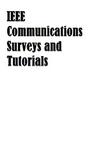版权所有:内蒙古大学图书馆 技术提供:维普资讯• 智图
内蒙古自治区呼和浩特市赛罕区大学西街235号 邮编: 010021

作者机构:Harbin Institute of Technology Communications Research Center China Simon Fraser University School of Engineering Science Canada University of Manitoba Department of Electrical and Computer Engineering Winnipeg Canada
出 版 物:《IEEE Communications Surveys and Tutorials》 (IEEE Commun. Surv. Tutor.)
年 卷 期:2024年
核心收录:
学科分类:0810[工学-信息与通信工程] 0808[工学-电气工程] 080802[工学-电力系统及其自动化] 0809[工学-电子科学与技术(可授工学、理学学位)] 08[工学] 0804[工学-仪器科学与技术]
主 题:Channel estimation
摘 要:Backscatter communication (BackCom) networks are expected to provide ultra-low-power transmission and massive connectivity in future wireless communication systems. Nevertheless, the double-fading effect significantly reduces signal intensity and is a primary problem of modern BackCom systems. Reconfigurable Intelligent Surface (RIS) can artificially modify the wireless environment through numerous controllable reflecting elements. With the help of RIS, the desired signals in the BackCom procedure can be captured and reflected in the specified direction, which is able to alleviate the double-fading problem. Specifically, RIS can be a backscatter device to send information instead of a collaborator to enhance transmission, yielding the RIS-BackCom mechanism. However, a comprehensive review of this technique still needs to be made available, dramatically limiting its development. This paper presents the fundamental principles and functions of legacy BackCom systems, the RIS technique, and RIS-BackCom networks. Then, we discuss the system-level performance with different modulation and channel estimation approaches. Further, we introduce symbiotic radio (SR) networks developed from the RIS-BackCom technique. After that, we provide a survey on diverse optimization issues existing in the applications of RIS-BackCom networks. Finally, we envision emerging use scenarios, potential challenges, and possible solutions in future wireless communication networks. © 1998-2012 IEEE.